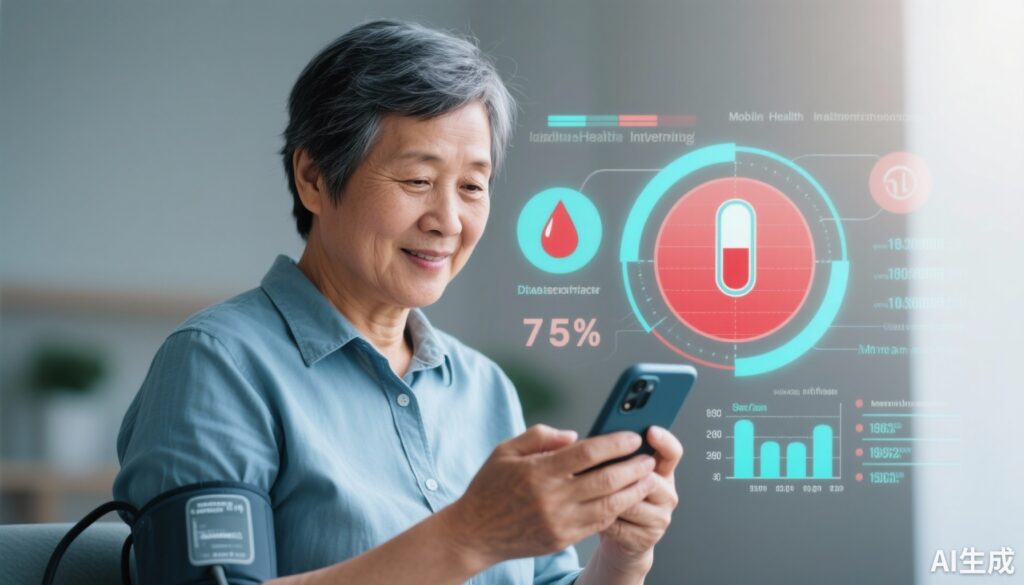Highlight
This large randomized clinical trial evaluated the effects of a mobile message-based intervention on controlling key cardiovascular risk factors in adults with uncontrolled type 2 diabetes (T2D). Over 12 months, the intervention led to modest but significant improvements in hemoglobin A1c (HbA1c) and systolic blood pressure (SBP) compared to usual care. These findings provide evidence supporting mobile health (mHealth) text messaging as a scalable adjunct in diabetes and cardiovascular risk management.
Importantly, while LDL cholesterol improved similarly in both groups, the combined improvements in glycemic and blood pressure control suggest potential clinical benefits. The intervention also increased the proportion of patients achieving HbA1c targets, a critical outcome in diabetes care.
Study Background and Disease Burden
Type 2 diabetes mellitus (T2D) is a prevalent chronic disease worldwide, characterized by hyperglycemia and associated with high risks of cardiovascular disease (CVD). Controlling cardiovascular risk factors—such as hyperglycemia, elevated blood pressure, and dyslipidemia—is essential for reducing morbidity and mortality in T2D patients.
Despite established guidelines advocating multifactorial risk factor management, implementation remains suboptimal globally, especially in resource-constrained settings. Patient engagement, adherence to lifestyle changes, and treatment regimens are critical barriers.
Mobile health (mHealth) interventions, particularly text message-based strategies, have emerged as promising tools for delivering education, reminders, and motivation at scale. However, robust evidence for their effectiveness across multiple cardiovascular risk factors in uncontrolled T2D populations has been limited.
Study Design
This study was a randomized clinical trial conducted at five clinical centers in China. A total of 819 adults with uncontrolled T2D (baseline mean HbA1c ~10.2%), concomitant with other cardiovascular risk factors, were enrolled from November 2018 to March 2022 and followed for 12 months.
Participants were randomly assigned to either the usual care group or the intervention group receiving a mobile message-based program. The intervention consisted of six text messages per week from various modules designed to remind, encourage, and motivate patients toward behaviors that improve glycemic control and cardiovascular risk management over one year.
Primary outcomes were mean changes in HbA1c, low-density lipoprotein cholesterol (LDL-C), and systolic blood pressure (SBP) from baseline to 12 months. The secondary outcome was the proportion of participants achieving HbA1c control at 12 months. Intention-to-treat analysis principles were applied.
Key Findings
Among 819 participants (67.4% men; mean age 50.1 years), 410 were assigned to the intervention, and 409 to usual care. Baseline HbA1c was similarly elevated in both groups (mean ~10.2%).
At 12 months, both groups showed reductions in the primary risk factors, but the intervention group demonstrated slightly greater improvements:
- HbA1c: Intervention group declined by -2.8% (95% CI, -2.9% to -2.6%); usual care declined by -2.5% (95% CI, -2.7% to -2.3%). Net difference: -0.3% (95% CI, -0.5% to -0.0%).
- LDL-C: Intervention group decreased by -11.1 mg/dL (95% CI, -14.7 to -7.4 mg/dL); usual care decreased by -11.9 mg/dL (95% CI, -15.8 to -8.0 mg/dL). Net difference: 0.9 mg/dL (95% CI, -4.5 to 6.2 mg/dL), indicating no significant difference.
- SBP: Intervention group lowered by -2.5 mm Hg (95% CI, -3.9 to -1.2 mm Hg); usual care changed by -0.1 mm Hg (95% CI, -1.6 to 1.3 mm Hg). Net difference: -2.4 mm Hg (95% CI, -4.3 to -0.4 mm Hg).
The combined overall effect assessing these risk factors was statistically significant (P = .001), suggesting meaningful aggregate improvements related to the intervention.
Regarding glycemic control targets, a significantly higher proportion of intervention participants achieved controlled HbA1c (<7.0% or an institution-defined target) at 12 months compared with usual care: 54.0% vs. 46.1% (P = .04).
The trial did not report on adverse events related to the intervention, suggesting safety in this context. The study did not find an intervention effect on LDL-C beyond usual care, possibly reflecting substantial lipid improvements in both groups due to standard treatments.
Expert Commentary
The findings align with previous evidence endorsing mobile technology to foster self-management in chronic diseases like diabetes. The modest HbA1c reduction of 0.3% beyond usual care, while statistically significant, represents a clinically relevant incremental benefit, especially in populations struggling with uncontrolled glucose levels.
Blood pressure improvement of ~2.4 mm Hg systolic may also translate into meaningful cardiovascular risk reduction. The lack of difference in LDL-C suggests the intervention’s focus or intensity might better target behavioral domains influencing glucose and blood pressure than lipid management, or that lipid-lowering treatments were similarly optimized in both arms.
Limitations include the study’s conduct in Chinese clinical settings, which may affect generalizability to other healthcare environments. The trial also relied on text message delivery only, and future research might explore integrated mHealth platforms with feedback or interactive components.
The combined effect of small improvements in multiple cardiovascular risk factors is encouraging and supports guidelines advocating comprehensive risk factor management in T2D. Notably, the pragmatic design with intention-to-treat analysis reinforces real-world applicability.
Conclusion
This well-powered randomized clinical trial demonstrates that a mobile message-based intervention can modestly but significantly improve glycemic control and systolic blood pressure over 12 months in adults with uncontrolled type 2 diabetes. While LDL cholesterol was similarly reduced in both groups, the intervention increased the proportion of patients reaching target HbA1c levels, an important clinical milestone.
These results underscore the potential of scalable, low-cost mobile health strategies to augment usual care, address longstanding gaps in cardiovascular risk factor control, and support patient engagement in self-management of T2D. Implementation of such interventions should be considered as part of integrative diabetes care.
Future research should investigate optimizing message content, frequency, and interactivity, assess long-term cardiovascular outcomes, and validate findings in diverse populations.
References
1. Zhang PZ, Guo D, Liu CQ, et al. Mobile App-Based Intervention and Cardiovascular Risk Factors in Patients With Uncontrolled Type 2 Diabetes: A Randomized Clinical Trial. JAMA Netw Open. 2025;8(9):e2529762. doi:10.1001/jamanetworkopen.2025.29762
2. American Diabetes Association. 11. Cardiovascular Disease and Risk Management: Standards of Medical Care in Diabetes—2023. Diabetes Care. 2023;46(Suppl 1):S158-S179. doi:10.2337/dc23-S011
3. Lee SWH, Ooi L, Lai YK. Mobile phone messaging reminders for diabetes management. Cochrane Database Syst Rev. 2017 Aug 4;8(8):CD007878. doi:10.1002/14651858.CD007878.pub3



